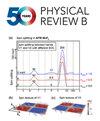通过选择交换耦合α−Fe2O3 /坡莫合金异质结构杂化界面的晶体取向,可调增强磁化动力学
IF 3.7
2区 物理与天体物理
Q1 Physics and Astronomy
引用次数: 0
摘要
我们研究了α−Fe2O3/Ni80Fe20 (Py)异质结构中的自旋动力学,揭示了通过控制晶体取向、温度和外加磁场来设计铁磁共振(FMR)频率的可靠机制。利用低温铁磁共振谱,我们证明了α−Fe2O3的nsamel矢量的相对取向和Py层的磁化强度在Morin转变温度(TM)上是高度可调的。我们发现的核心是晶体取向在控制自旋动力学中的关键作用,而nsamel矢量的重新取向作为一种补充机制,可以进一步调节系统的行为。我们的实验和证实的理论模型揭示了不同晶体取向的不同共振行为,突出了相互nsamel矢量和磁化几何形状在决定FMR频率中的关键作用。通过这种方式,我们可以通过操纵相互的nsamel矢量/磁化配置将FMR频率调高到10倍。我们的研究包括所有常见的α−Fe2O3晶体取向,并对随之而来的自旋动力学进行了统一的理论描述。2025年由美国物理学会出版本文章由计算机程序翻译,如有差异,请以英文原文为准。
Tunable enhancement of magnetization dynamics by selection of the crystallographic orientation of the hybrid interface of exchange-coupled α−Fe2O3 /permalloy heterostructures
We investigate spin dynamics in α−Fe2O3/Ni80Fe20 (Py) heterostructures, uncovering a robust mechanism for designing the ferromagnetic resonance (FMR) frequency through control of crystal orientation, temperature, and applied magnetic field. Employing cryogenic ferromagnetic resonance spectroscopy, we demonstrate that the relative orientation of the Néel vector of α − Fe 2 O 3 T M α − Fe 2 O 3 Published by the American Physical Society 2025
求助全文
通过发布文献求助,成功后即可免费获取论文全文。
去求助
来源期刊

Physical Review B
物理-物理:凝聚态物理
CiteScore
6.70
自引率
32.40%
发文量
0
审稿时长
3.0 months
期刊介绍:
Physical Review B (PRB) is the world’s largest dedicated physics journal, publishing approximately 100 new, high-quality papers each week. The most highly cited journal in condensed matter physics, PRB provides outstanding depth and breadth of coverage, combined with unrivaled context and background for ongoing research by scientists worldwide.
PRB covers the full range of condensed matter, materials physics, and related subfields, including:
-Structure and phase transitions
-Ferroelectrics and multiferroics
-Disordered systems and alloys
-Magnetism
-Superconductivity
-Electronic structure, photonics, and metamaterials
-Semiconductors and mesoscopic systems
-Surfaces, nanoscience, and two-dimensional materials
-Topological states of matter
 求助内容:
求助内容: 应助结果提醒方式:
应助结果提醒方式:


